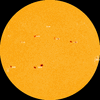SOLAR CYCLE 25 ACTIVITY REPORT DECEMBER 22_2023


There are currently 8 sunspot regions on the solar disk: AR3519, AR3521, AR3524 AR3626 AR3528, AR3529, AR3530, AR3531

AR3523 & AR3527 are gone
● Auroral Activity
Aurora Oval Bz: -2.72 nT South

● Current Conditions at 04:25 UTC on December 22th
▪︎ Geospace quiet (Kp 1)
▪ Solar wind speed record: 360 km/sec (Normal speed)
▪︎ density: 2.5 p/cm³ (low density)
▪︎ Interplanetary Magnetic Field (IMF)
Bt: 5.48 nT
▪︎ Thermosphere Climate Index
today: 19.84x1010 W Warm
▪︎ Neutron Counts today: - 5.0 % (Low)
▪︎ X-ray Solar Flare: M3 0004 UT Dec22 from AR3519 (S52W72) the flare caused a Minor R1 radio blackout over South Pacific Ocean


▪︎ Sunspot number:138(SN 133 December 21)
▪︎ Spotless Days 2023 total: 0 days (0%)
• There are no significant coronal holes on the Earthside of the sun
............
SpaceWeatherlive.com
SpaceWeather.com
Solar activity has been at moderate levels for the past 24 hours. The largest solar event of the period was a M4 event observed at 05:38 UTC on December 21th from Region 3519 (S12W72) the flare caused a Minor R1 radio blackout over East Indian Ocean
There are currently 8 sunspot regions on the solar disk: AR3519, AR3521, AR3524 AR3626 AR3528, AR3529, AR3530, AR3531
AR3523 & AR3527 are gone
Total number of sunspots has increased to 138 (58 of these are grouped into 10 active regions) NOAA forecasts for the next 24h: 99% chance for C flares, 40% chance M flares and 5% chance for X flares.
AR3529 has lost its a delta component but remains with a beta-gamma magnetic field that harbors energy for M-class flares. Now AR3528 has a stable magnetic fields and AR3521 has developed a beta-gamma magnetic field. These sunspots are facing the Earth.
AR3529 has lost its a delta component but remains with a beta-gamma magnetic field that harbors energy for M-class flares. Now AR3528 has a stable magnetic fields and AR3521 has developed a beta-gamma magnetic field. These sunspots are facing the Earth.
● Auroral Activity
The geomagnetic field has been at quiet to unsettled (Kp 3) levels for the past 24 hours. On December 21th Solar wind speed reached a peak of 440 km/s (Moderately high speed) at 21:36 UTC.
Aurora Oval Bz: -2.72 nT South
● Current Conditions at 04:25 UTC on December 22th
▪︎ Geospace quiet (Kp 1)
▪ Solar wind speed record: 360 km/sec (Normal speed)
▪︎ density: 2.5 p/cm³ (low density)
▪︎ Interplanetary Magnetic Field (IMF)
Bt: 5.48 nT
▪︎ Thermosphere Climate Index
today: 19.84x1010 W Warm
▪︎ Neutron Counts today: - 5.0 % (Low)
▪︎ X-ray Solar Flare: M3 0004 UT Dec22 from AR3519 (S52W72) the flare caused a Minor R1 radio blackout over South Pacific Ocean
▪︎ Sunspot number:138(SN 133 December 21)
▪︎ Spotless Days 2023 total: 0 days (0%)
• There are no significant coronal holes on the Earthside of the sun
............
SpaceWeatherlive.com
SpaceWeather.com







